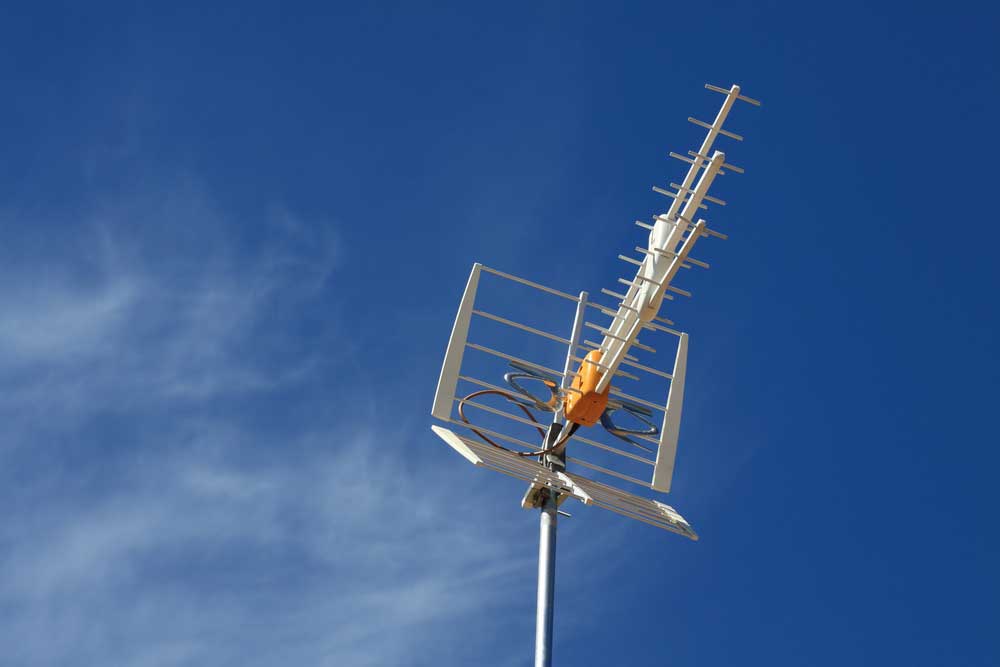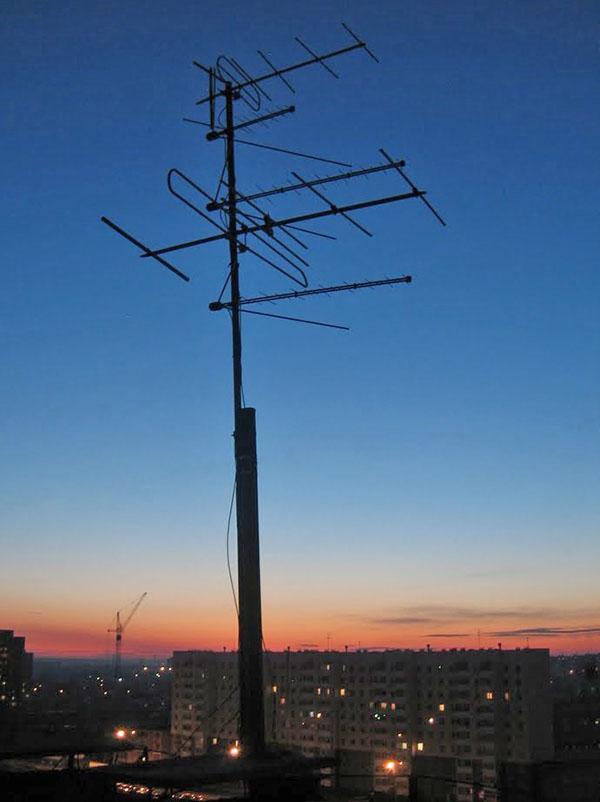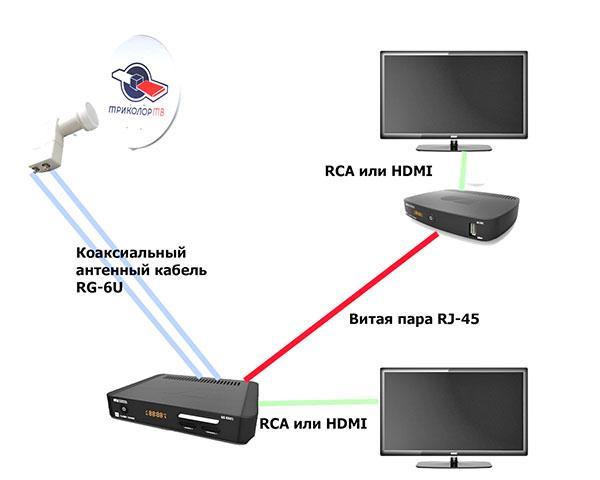Selection and installation of an antenna for a summer residence
 Even on vacation, a person wants to keep abreast of the latest news, receiving relevant information through television. To receive a high-quality TV signal, an antenna for a summer residence is needed, which is suitable for a specific area in terms of technical capabilities. Its choice depends on the type of signal transmission and the distance of the TV tower.
Even on vacation, a person wants to keep abreast of the latest news, receiving relevant information through television. To receive a high-quality TV signal, an antenna for a summer residence is needed, which is suitable for a specific area in terms of technical capabilities. Its choice depends on the type of signal transmission and the distance of the TV tower.
Antenna types
Today, there are several types of antennas that differ in image transmission quality and equipment cost:
- Analog TV. Uses an electrical signal in a certain wavelength range to transmit images and sound. It is dominant on terrestrial terrestrial channels in Russia. The minimum cost of the antenna is 200-500 rubles. The quality of the transmitted image is average. In adverse weather conditions, the transmitted signal may not be recognized by the equipment. Channel range: 4 to 15.

- Satellite television. The broadcast of the TV signal is transmitted to the consumer via an artificial satellite located in the Earth's orbit. To receive waves, special equipment is required, configured for retransmission. At the dachas, dish antennas are installed, supporting more than a hundred TV channels. The signal strength is constant and does not depend on the terrain. The minimum cost of equipment: 5000 rubles. It is also necessary to pay an annual fee for a single package of TV channels.

- Digital television. Transmission of television images and sound with a special coded video signal. Having installed a terrestrial UHF antenna and a set-top box (Set Top Box) with a tuner, you can watch up to 15-20 channels in good quality. In modern TV models, a supporting format has already been set, you just need to correctly configure the antenna. If the television tower that distributes the waves is far from the summer cottage, then the signal may be interrupted and disappear. In remote villages located in mountainous or forested areas, digital television does not work.

When choosing an antenna for a TV, it is necessary to take into account the location of the site, the distance of the repeater tower and the presence of natural or artificial obstacles to the TV signal - hills, tall trees, thick walls.
Indoor or outdoor
 An indoor antenna for a summer residence is used to cover a small communication range. Installed in summer cottages located in close proximity to the repeater. Picks up the signal in the suburbs, near highways and highways. If the house is near a power line, the signal may become intermittent, making the image unclear.
An indoor antenna for a summer residence is used to cover a small communication range. Installed in summer cottages located in close proximity to the repeater. Picks up the signal in the suburbs, near highways and highways. If the house is near a power line, the signal may become intermittent, making the image unclear.
An indoor TV antenna for a summer residence can be made by hand. Attach the aluminum wire to the corresponding socket on the TV and fasten it to the ceiling with a thread. Move the antenna carefully to locate where the signal is best received.
The higher the indoor antenna is located, the better the image will be transmitted to the TV receiver. Signal reception increases near window and doorways.
 An outdoor antenna is installed at dachas located more than 10-15 km from the repeater. It is indispensable in summer cottages located in lowlands, in hilly terrain, surrounded by forests.
An outdoor antenna is installed at dachas located more than 10-15 km from the repeater. It is indispensable in summer cottages located in lowlands, in hilly terrain, surrounded by forests.
Broadband or narrow beam
 A broadband television antenna for a summer residence belongs to all-wave equipment. A compact device with built-in three broadband lines receives transmitted signals at all frequencies, broadcasting high-quality picture and sound. The broadband antenna is bulky and has a long shaft.
A broadband television antenna for a summer residence belongs to all-wave equipment. A compact device with built-in three broadband lines receives transmitted signals at all frequencies, broadcasting high-quality picture and sound. The broadband antenna is bulky and has a long shaft.
An all-wave television antenna with an amplifier requires a special installation at a summer cottage. Improperly mounted equipment can transmit poor quality images during bad weather.
 A narrow beam antenna receives a signal only in one range of UHF or MV frequencies. With the help of a cable and a connector, the equipment can be made by hand. Channel range: 2-6. Image quality depends on weather and terrain conditions. Signal interruption and disappearance are possible.
A narrow beam antenna receives a signal only in one range of UHF or MV frequencies. With the help of a cable and a connector, the equipment can be made by hand. Channel range: 2-6. Image quality depends on weather and terrain conditions. Signal interruption and disappearance are possible.
Active or passive
 The active equipment is equipped with a signal quality amplifier built into the body. Antennas receive more channels, the image does not disappear in adverse weather conditions. Average equipment price: 300-600 rubles.
The active equipment is equipped with a signal quality amplifier built into the body. Antennas receive more channels, the image does not disappear in adverse weather conditions. Average equipment price: 300-600 rubles.
An active TV antenna is installed on the roof of the summer cottage or on a special pole.
Once every 2-3 years, the board in the amplifier needs to be replaced due to oxidation of the contacts and elements. Otherwise, the number of received channels will decrease and the image quality will deteriorate. Due to power surges during thunderstorms, the board may burn out.
The oxidation process of the contacts can be slowed down by pouring silicone on both sides of the new board. Seal the cable connection to improve the quality of the received signal.
 Passive antennas are an amplifier-less design. It must be purchased separately and additionally attached to the antenna. The amplifier is installed in the attic and is attached to the equipment using a special connector and cable. This simplifies replacement of a worn-out board: there is no need to climb onto the roof and repair equipment.
Passive antennas are an amplifier-less design. It must be purchased separately and additionally attached to the antenna. The amplifier is installed in the attic and is attached to the equipment using a special connector and cable. This simplifies replacement of a worn-out board: there is no need to climb onto the roof and repair equipment.
The number of channels transmitted by a passive antenna is less, but the image and sound quality is higher. Signals are not interrupted during wind and rain.
A passive antenna is the best choice for a summer residence. Separate amplifiers can be configured for 2 ranges of UHF and MV. If the site is located far from the repeater, then some signals are clogged with stronger waves and do not give a clear image. Wave overlap occurs, interference occurs. Adjusting the range sensitivity individually will help to deal with this problem.
In modern models of TVs "LG" and "Samsung" there is a function "weak signal amplification". In this case, you do not need to connect the amplifier to a passive antenna. When the mode is turned on and the equipment is configured correctly, the TV will show at least 4-5 channels.
Choosing an antenna for a summer residence
Each owner of a summer cottage is worried about how to choose an antenna for a summer residence. First of all, decide on the type of antenna and the manufacturer of the product. This will help you with expert advice, user recommendations and feedback from friends.
Popular manufacturers of television equipment:
- Locus. The Russian company has existed on the TV receiving antenna market since 1998. A whole line of products for cable and terrestrial television has been created. The manufacturer offers active and passive antennas, amplifiers, receivers and accessories at a reasonable price. The cost of the antenna varies from 500 to 2000 rubles. The assortment is constantly being supplemented and updated.

- Harpoon. The company presents passive antennas made in Russia. The equipment accepts in the UHF and MW bands. Antennas are recommended for installation in areas with uncertain wave reception. Product price: 1600-2600 rubles.

- Delta. The Russian company offers a wide range of narrow beam and broadband antennas.Some models have a built-in F-connector through which the cable is connected. The equipment receives signals at a great distance from the TV tower. Image quality does not depend on weather conditions.

- GoldMaster. Popular manufacturer of television equipment. Antennas are intended for areas of uncertain coverage. The signal remains clear even in adverse weather conditions. Digital antennas for summer cottages are presented. Equipment cost: 700-2500 rubles.

- REMO. The Russian manufacturer of antennas for digital terrestrial television has been on the market since 1991. The assortment is represented by television antennas, equipment for signal transmission and reception, amplifiers, Internet providers. The company's products are patented, protected from counterfeiting and copying.

Company specialists or television equipment consultants will help you choose the right TV antenna for your summer residence. Additionally, you can order the installation and tuning of the antenna, issue a post-warranty service coupon.
Correct installation of the antenna in the country
 Before starting the installation of the antenna in the country, determine the location of the equipment. In settlements located far from the repeater, the antenna is mounted on the roof or on a special pole. The equipment is connected to the metal mast using special clamps.
Before starting the installation of the antenna in the country, determine the location of the equipment. In settlements located far from the repeater, the antenna is mounted on the roof or on a special pole. The equipment is connected to the metal mast using special clamps.
For a garden antenna with a built-in amplifier and receiver, choose a folding mast. This will facilitate the process of replacing the board, cleaning contacts, and repairing equipment.
You can fix the antenna on a wooden or metal pole 6-9 cm in diameter. Fix the mast to a fixed part of the house or outbuilding. You can attach a pole to a tree or a post dug in near the dacha.
If the house and the roof are solidly finished, the antenna is attached to the building gable. It is not recommended to install the equipment on siding walls and aerated concrete. This is difficult and can deform the walls.
 It is best to install the structure at the highest point of the roof. With the help of metal rings, the mast can be fixed to a pipe, rafters, ridge. Using special braces, the antenna is fixed to the roof.
It is best to install the structure at the highest point of the roof. With the help of metal rings, the mast can be fixed to a pipe, rafters, ridge. Using special braces, the antenna is fixed to the roof.
Necessary tool for work:
- electric drill;
- screwdriver with nozzles;
- drill;
- hammer;
- spanners.
Fix the antenna frame in the form of an iron corner with brackets, bolts or special brackets. First make small holes for the fasteners. Then insert anchor bolts with a diameter of 0.1 cm into them.
Stretches will provide a firm fixation of the equipment. The cables are attached to the mast, securing the antenna in a certain position. Stretch marks will protect the antenna from wind load, improving the quality of the received signal.
When attaching an external television antenna to the pediment, remember that the distance between the mountings must be at least 1.2 m. Otherwise, the structure will be unstable, and in windy weather the signal may be interrupted and disappear.
Antenna Installation Tips:
- The antenna line should not be completely aligned with the power line. This can lead to short circuits, sound and picture distortion.
- Use a safety rope and a secure ladder when installing the antenna. Do not mount the antenna on a wet and snowy roof.
- Set up the equipment in pairs. One person turns the pole with the antenna, the other captures the image transmission to the TV.
If the signal is weak, move the mast with the antenna to a more open place. Do not install the equipment near large trees.
If the quality of the air connection is poor, contact a competent antenna repair and maintenance technician. It is difficult to detect and eliminate the malfunction on your own. Cables or connectors, antenna combiner, plug or socket can be damaged. The specialist will quickly and efficiently eliminate the malfunction and set up the equipment.
Attaching the cable to the equipment
 Choose a branded cable SAT 50 or SAT 703. The clarity of the picture and sound depends on the quality of the cable. Do not purchase wire from questionable suppliers. Before buying, study the safety certificate, the product must pass the necessary quality control.
Choose a branded cable SAT 50 or SAT 703. The clarity of the picture and sound depends on the quality of the cable. Do not purchase wire from questionable suppliers. Before buying, study the safety certificate, the product must pass the necessary quality control.
In the process of installing the antenna, the cable is lowered down the mast, securing it with clamps every 40-70 cm. Having lowered the cable to the level of the roof, it is necessary to stretch it along the ridge and bring it to the bracket, which is fixed near the window opening. Having fixed the wire on the bracket, you need to bring the cable into the room by pushing it through the hole in the window frame.
Drill the hole in the window frame with an upward slope. This prevents rain drops from entering the room.
If the external antenna for the TV is inactive, and the amplifier is installed in the attic, then the cable from the antenna must first be routed to it, and then brought to the TV. Avoid kinks and kinks when routing the cable. Do not pinch the wire with staples or cable ties, as this may deteriorate the picture and sound quality.
Before starting work, coat all bolts, nuts and antenna connections with Movil or Litol. The treatment helps to extend the life of the antenna and protect the parts from oxidation and rust.
Antenna grounding
 Most experts are unanimous in the opinion that grounding the antenna in the country is necessary. This will reduce the electrical voltage to a safe level and prevent the equipment from being ignited by a lightning strike. The down conductors are connected to the grounding devices, and the lightning discharge is redirected to the ground.
Most experts are unanimous in the opinion that grounding the antenna in the country is necessary. This will reduce the electrical voltage to a safe level and prevent the equipment from being ignited by a lightning strike. The down conductors are connected to the grounding devices, and the lightning discharge is redirected to the ground.
With grounded equipment, the amount of noise is reduced, the picture and sound become better.
Grounding options:
- Antenna reduction plug is connected to the plug socket. The wire is soldered to the socket, connecting to ground.
- The two-wire cord is soldered to the core and sheath of the drop wire. The cores of the cord are stripped of insulation, soldered and connected to the ground wire.
Grounding can be traditional or internal. With traditional grounding, lightning rods and down conductors are installed. Internal grounding provides for work to protect electrical wiring in the country house.
Opponents of grounding appeal that all lightning strikes that occur nearby will hit the antenna. This is fraught with burnout of the board and amplifier, which will need to be replaced. If the antenna is below the power line, it does not need to be grounded. Lightning always strikes the highest grounded point.
Every summer resident asks the question of which antenna to buy for the country. Today the market offers a wide range of equipment, differing in principle of operation, power, size, weight and cost. The choice of antenna should be based on the terrain and the distance of the TV tower. With the correct selection and installation of equipment, the TV will delight summer residents with high-quality images and sound in any weather.